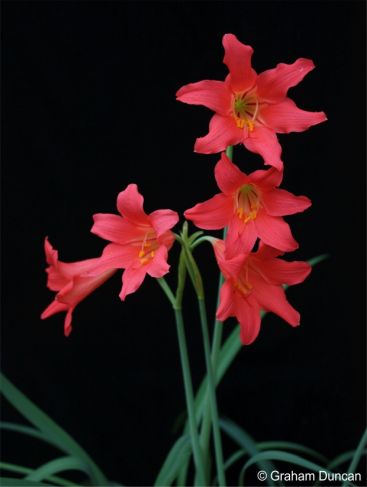Cyrtanthus sanguineus
Cyrtanthus sanguineus (Lindl.) Walp.
Family: Amaryllidaceae
Common names: Kei lily, Inanda lily, Nahoon lily, large red cyrtanthus, fire lily (Eng.), Keilelie, vuurlelie (Afr.), isilawu esimhlophe (isiXhosa).
Introduction
Kei lily is a bulbous plant that forms clumps of strappy leaves. It does well as a bedding plant in light shade, providing colour to any dull flower bed with its beautiful bright red flowers in late summer, between January and April. It can also be planted in a hanging basket or as a pot plant.

Description
Description
Cyrtanthus sanguineus is a perennial bulb that grows 150 to 300 mm high. The tunicate bulb has an oval shape with a 50 mm diameter and it normally grows above ground. The lush green strap-like leaves are 400 mm long and about 80 mm wide and grow in clumps. It produces funnel-shaped, red flowers with curled lobes on a 300 mm long flower stalk. The flowers have a subtle scent, and they are produced in late summer to autumn, between January and April.

Conservation Status
Status
Cyrtanthus sanguineus is assessed as Least Concern (LC) according to Red List of South African Plants. This means that the plant population is stable in the wild and it is currently at low risk of extinction.
Distribution and habitat
Distribution description
Cyrtanthus sanguineus is widespread in the Eastern Cape and KwaZulu Natal provinces of South Africa, from the coast to 600 m altitude, and in the eastern tropical African countries, Kenya, Tanzania and Sudan. It naturally grows near water courses, on rocky, south-facing slopes and in rock crevices.

Derivation of name and historical aspects
History
The genus Cyrtanthus was described by Kew Botanist William Aiton in 1789. The genus name is derived from Greek kyrtos meaning ‘curved’ and anthos meaning ‘flower’, this was referring to the curved tubular flowers of some of the species in the genus. The species name sanguineus means ‘blood red’, probably referring to the colour of the flowers.
Ecology
Ecology
The bright red flowers attract the brown-and-yellow Table Mountain Beauty butterfly (Aeropetes tulbaghia), which pollinates them.
Uses
Use
Cyrtanthus sanguineus has been cultivated since 1846 as an ornamental garden plant. Its uses are not limited to providing striking colour to any flower bed, it does well in a pot or hanging basket. It is also used medicinally during pregnancy to facilitate a smooth delivery. The Xhosa people use it as a medicine to induce nausea and vomiting and its leaves are added to bath water.

Growing Cyrtanthus sanguineus
Grow
Cyrtanthus sanguineus can be propagated by lifting a clump and separating the bulblets growing underground and planting them as new plants. This method should be conducted in spring, after flowering. The offsets need to be planted with the bulb necks exposed, immediately after separating them from the main bulb. Use an acid or neutral growing medium that drains well, such as equal parts of loam, finely sifted acid compost and coarse grit/river sand. After planting, water the plants by drenching the container then repeat once or twice per week, allowing the medium to dry out in between watering. Propagated plants must be placed in a well ventilated green house with enough sunlight, especially in the mornings.
It can also be propagated by seed, sown as soon as it is ripe, in deep seed trays using a sandy medium, planted just below the surface and well-spaced to avoid damping-off. Pot up into larger containers in their second season.
Plant the bulbs with the upper third exposed. The plants like to grow in crowded clumps, flowering best when in a crowd, and should be left undisturbed for many years. Place them in semi-shade, or light shade. Plants are half hardy and can withstand temperatures to 0°C.
Be on the lookout for lily borers, mealy bugs and snails, which attack both the leaves and bulbs of C. sanguineus.
References
- Candotti, P. 2022-02. Observation of Cyrtanthus sanguineus, Molweni, Ngqungqulu, KZN. iNaturalist. Online. https://www.inaturalist.org/observations/107122655.
- Du Plessis, N. & Duncan, G. 1989. Bulbous plants of southern Africa, a guide to their cultivation and propagation. Tafelberg, Cape Town.
- Duncan, G. 2021. Cyrtanthus Ait. (Amaryllidaceae). Plantzafrica. Online. https://pza.sanbi.org/cyrtanthus.
- Duncan, G. 2010. Grow bulbs. A guide to the cultivation of bulbs of South Africa and neighboring countries. Kirstenbosch Gardening Series. South African National Biodiversity Institute, Cape Town.
- Manning, J. & Goldblatt, P. 2012. Plants of the Greater Cape Floristic Region 1: the Core Cape Flora. Strelitzia 29. South African National Biodiversity Institute, Pretoria.
- Plants of the World Online. Cyrtanthus sanguineus (Lind.) Walp. https://powo.science.kew.org/taxon/urn:lsid:ipni.org:names:64253-1. Accessed 4/7/24.
- Pooley, E. 1998. A field guide to wild flowers of Kwazulu-Natal and the eastern region. Natal Flora Publications Trust, Durban.
- Raimondo, D., Von Staden, L., Foden, W., Victor, J.E., Helme, N.A., Turner, R.C., Kamundi, D.A. & Manyama, P.A. (eds) 2009. Red list of South African plants. Strelitzia 25. South African National Biodiversity Institute, Pretoria.
- Ralston, C. 2023-01. Observation of Cyrtanthus sanguineus, Garden Route Botanic Garden, George, Western Cape. iNaturalist. Online. https://www.inaturalist.org/observations/146772202.
Credits
Itumeleng Machete
Pretoria National Botanical Garden
July 2024
Acknowledgements: the author thanks Graham Duncan, Geoff Nichols, Colin Ralston and Paolo Candotti for the pictures.
Plant Attributes:
Plant Type: Bulb
SA Distribution: Eastern Cape, KwaZulu-Natal
Soil type: Loam
Flowering season: Late Summer, Autumn
PH: Acid, Neutral
Flower colour: Red
Aspect: Morning Sun (Semi Shade), Afternoon Sun (Semi Shade)
Gardening skill: Average
Special Features:
Horticultural zones








Rate this article
Article well written and informative
Rate this plant
Is this an interesting plant?
Login to add your Comment
Back to topNot registered yet? Click here to register.